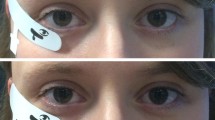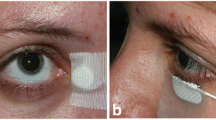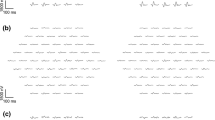Abstract
Dermal electrodes allowed the recording of retinal oscillatory potentials with similar shape and timing as tracings obtained with convential corneal electrodes. Normative data is presented. We concluded that dermal electrodes were a reproducible and more comfortable method of testing.
Similar content being viewed by others
References
Armington JC. The electroretinogram. New York: Academic Press, 1974.
Bresnick GH, Kort K, Groo A, Palta M. Electroretinographic oscillatory potentials predict progression of diabetic retinopathy. Arch Ophtalmol 1984; 102: 1307–1311.
Cooper R, Osselton JW, Shaw JC. EEG technology. London: Butterworth, 1960.
Evans CR, Mulholland TB eds. Attention in neurophysiology. London: Butterworths, 1969.
Giltrow-Taylor J, Crews S, Drasdo N. Electroretinography with noncorneal and corneal electrodes. Invest Ophthalmol Vis Sci 1973; 17: 1124–1127.
Harden A. A non-corneal electroretinogram. Br J Ophthalmol 1974; 58: 811–816.
Ogden T. The oscillatory waves of the primate electroretinogram. Vis Res 1973; 13: 1059–1074.
Papakostopoulos D. Clinical electrophysiology of the human visual system. In: Clinical application of cerebral evoked potentials in pediatric medicine, Chiarenza GA, Papakostopoulos D eds. Amsterdam: Excerpta Medica, 1982; 3–40.
Regan D. Evoked potentials in psychology, sensory physiology and clinical medicine. London; Chapman and Hall, 1972.
Siegel M. Non-parametric statistics: for the behavioral sciences. New York: McGraw-Hill, 1956.
Speros P Price J. Oscillatory potentials: history, techniques and potential use in the evaluation of disturbances of retinal circulation. Surv Ophthalmol, 1981; 25: 237–252.
Tepas DI, Armington JC. Electroretinogram from non-corneal electrodes. Invest Ophthalmol 1962; 1: 784–786.
Wachtmeister L. Further studies of the chemical sensitivity of the antagonists. Acta Ophthalmol 1980; 58: 712–725.
Wachtmeister L. Further studies of the chemical sensitivity of the oscillatory potentials of the electroretinogram. II. Glutamate, aspartate and dopamine antagonists. Acta Ophthalmol 1981a; 59: 247–258.
Wachtmeister L. Further studies of the chemical sensitivity of the oscillatory potentials of the electroretinogram. III. Some aminoacids and ethanol. Acta Ophthalmol 1981b; 59: 609–619.
Wachtmeister L, Dowling J. The oscillatory potentials of the mudpuppy retina. Invest Ophthalmol Vis Sci 1978; 17: 1176–1188.
Author information
Authors and Affiliations
Rights and permissions
About this article
Cite this article
Sannita, W.G., Maggi, L. & Fioretto, M. Retinal oscillatory potentials recorded by dermal electrodes. Doc Ophthalmol 67, 371–377 (1987). https://doi.org/10.1007/BF00143955
Issue Date:
DOI: https://doi.org/10.1007/BF00143955




